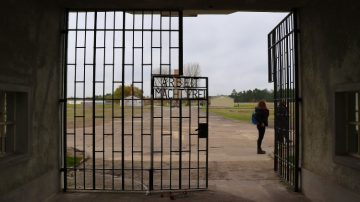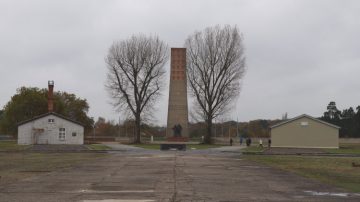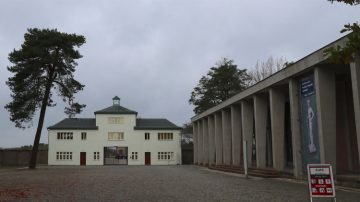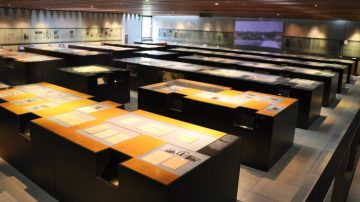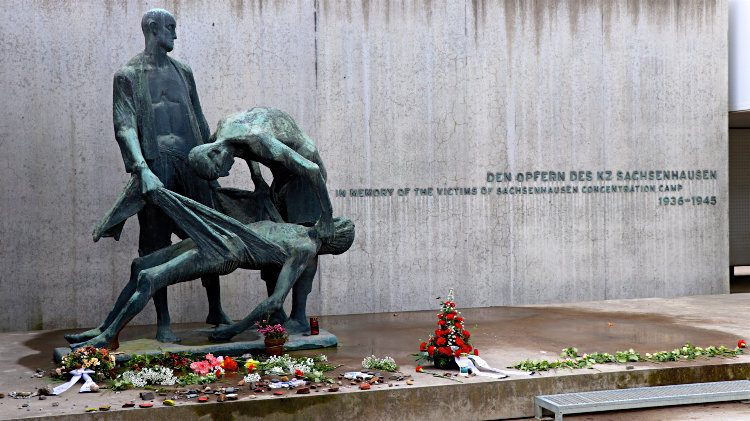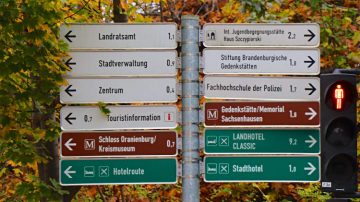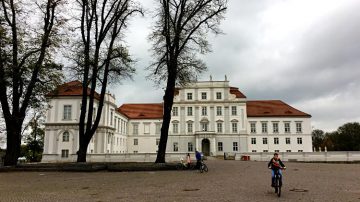Visiting the Sachsenhausen concentration camp memorial and museums in Oranienburg on a day trip is easy by train, bus, or guided tour from Berlin.
KZ Sachsenhausen is the closest major former Nazi concentration camp to Berlin. It is an interesting day trip from Berlin to Oranienburg to see this notorious site. The memorial site is open daily but the museums are closed on Mondays during the winter season. Getting to Oranienburg and Sachsenhausen from Berlin is easy by train or organized guided tours. The more difficult part of a visit is to take it all in and to try and comprehend how this all could have happened.
Sachsenhausen Concentration Camp near Berlin
Sachsenhausen Concentration Camp (Konzentrationslager (KZ) Sachsenhausen) was the first major concentration camp designed by an SS architect. It was to be a model for future camps and served as a training center for guards.
KZ Sachsenhausen was used by the Nazis from 1936 to 1945. During this period, an estimated 200,000 people were interned here – only 140,000 were documented. An estimated 30,000 people died here, including between 13,000 and 18,000 Soviet prisoners of war.
Like Dachau near Munich, Sachsenhausen was originally more of a jail for political prisoners and other “social undesirables” with many prisoners being freed again for a variety of reasons. No matter what the sign on the gate claimed, nobody was ever released for hard work.
Being only 30 km from the German capital, many prominent people were held here – often for short periods before being sent elsewhere. (See Wikipedia, the list is even longer on the German version of the page.)
During the war, Sachsenhausen functioned mostly as a forced labor camp with work ranging from brick making to the construction of aircraft and falsifying foreign currency.
Although Soviet soldiers were executed en masse, Jewish prisoners were mostly transported to extermination camps elsewhere, especially Auschwitz, and thus not included in the death statistics.
Shortly before liberation by the Soviet Army on 22 April 1945, the guards sent 33,000 of the remaining 38,000 prisoners on forced “death marches” during which an estimated 6,000 died.
From 1945 to 1950, part of the camp was used as a prison by the Soviet military. During this period, around 60,000 people were imprisoned here, of which 12,000 died. This history was kept secret after the East German regime changed Sachsenhausen into a memorial site in 1961. The mass graves from this period were only discovered in the 1990s and were mostly children, youths, women and old men.
KZ Sachsenhausen should not be confused with KZ Oranienburg, which was used from 1933 to 1934. It was in a disused factory building in the center of town.
Visiting Sachsenhausen Memorial and Museums
The Sachsenhausen memorial site is a large site with several museums and information sites. Even when concentrating on the main sights and only taking in a limited number of information panels, expect to spend two to three hours here.
Visiting Sachsenhausen requires a lot of walking and a lot of reading – information is in both German and English with information in other languages available from the visitor’s center. Both the volume of information available and the subject matters are too much to take in on a single visit.
The exhibitions and information panels explain in detail the atrocities, crimes, and brutality of Sachsenhausen and the concentration camps system. Below is just a brief description of what visitors may see and an indication of where most will find the more interesting exhibitions.
TIP: If time is limited, give priority to the exhibition in the former kitchen and the Station Z area.
Buy a map at the visitor’s center and proceed to the camp entrance that is quite a walk away with several information panels en route. The house of the camp commandant (grey) and the SS Troop House (green) are usually not open.
Exhibitions at Sachsenhausen Memorial Site
The New Museum before the entrance into the camp itself is of very minor interest to foreign visitors, although it has an interesting DDR era stained glass window right at the entrance. Much of the exhibition is simply on how the site was treated from 1960 to 1990. Few visitors would regret skipping it altogether and spending more time at the more interesting exhibitions inside the camp.
Visitors enter the former camp through the famous Arbeit Macht Frei (Work Makes Free) gate in the main guard tower. From here, most of the camp can be seen. The idea of the original triangular design was that the whole camp could be controlled from a single tower – this was impractical, especially when a camp was later enlarged, and the design was not repeated elsewhere.
Right in front of the guard tower was the Appellplatz (roll call area) with gallows in the back and to the right part of the boots testing track where prisoners were forced to march for hours to test new military boots.
White outlines mark the foundations of former barracks – most buildings here are copies. The site was only partly preserved once the East German regime decided in 1961 to erect a memorial to the anti-fascist struggle here with a very skewed view of history.
The security system near the wall was reconstructed in 1961. Prisoners were shot without warning if entering this neutral death zone. To prevent suicides guards aimed mostly at the legs.
To the right are two reconstructed barracks: 38 has exhibitions on Jewish prisoners and 39 shows everyday life in the camp. The adjacent prison building is original and was used by the Gestapo and SS for punishments and torture. The cells have several memorials for foreign resistance fighters and soldiers who died in the camp.
The exhibition in the former prisoners’ kitchen has the most interesting displays. It focuses on key events and gives a good overview of life in the camp. For most visitors, this is probably the most interesting of all the exhibitions at the site. This is probably the best place to start a visit to the memorial even if it means backtracking to the barracks later.
Behind the kitchen is the tall memorial erected by the DDR when the site was declared the official national memorial site in 1961. The 18 red triangles refer to the colors the political prisoners had to wear. The DDR emphasized the struggle of socialists and especially communists against the Nazi regime and much of the crimes and excesses were conveniently blamed on the capitalists and thus absolving the working classes.
At the far back of the site is a further guard tower with an exhibition (not particularly interesting) on the relationship between the camp and town.
Directly behind, is an exit to the adjacent camp used by the Soviets from 1945 to 1950. Several buildings survived and a large documentation center has extensive details on the Soviet abuses. Although this use of the camp between 1945 to 1950 was an absolute crime on its own, most visitors will be more interested in the main camp and Nazi era.
A gap in the wall near the memorial monument leads to the most disturbing area of the camp. This so-called “Station Z” was a typical Nazi naming: the crematorium and mass murder area that meant the end of the line for the unfortunate prisoner. Although Sachsenhausen had some gas chambers – for experimentation and training mostly – mass murder here was mostly by bullet.
The majority of people purposely killed at Sachsenhausen were Soviet prisoners of war. They were either shot en masse in an open trench or through a special system. Prisoners received a medical inspection – mostly to see who had valuable gold teeth fillings – and then led one by one into a room to be measured. As soon as a hole was covered by the prisoner’s neck, he was shot from the adjacent room – even the SS found it easier to kill when not having to face the victim.

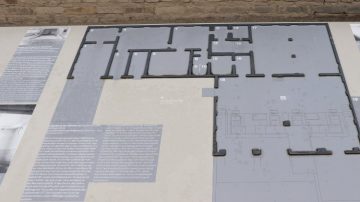
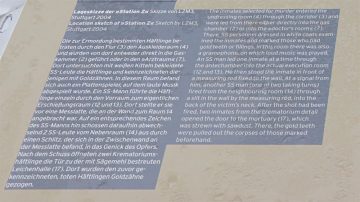
The pathology building, mortuary cellars and infirmary barracks to the left of the main entrance are original and have a huge exhibition on the medical care and medical crimes in the camp. This exhibition has an enormous amount of information panels. It is probably more sensible to study a few in detail than trying to take it all in.
Sachsenhausen Memorial Visitors Information
Sachsenhausen Concentration Camp Opening Hours
The Sachsenhausen Memorial grounds and visitors’ information center is open daily from 8:30 closing at 16:30 from mid-October to mid-March and 18:00 from mid-March to mid-October.
The museums and indoor exhibitions at the Sachsenhausen Memorial are open from 11:00 to 15:00 and are closed on Monday during the winter season.
The Sachsenhausen Memorial and Museums are open on vacation days but hours are shorter over the Christmas and New Year’s holiday periods.
Although all are welcome to visit, the contents and pictures presented in the exhibitions and on the Memorial site are not suitable for children under 12 years of age.
Admission is free to the grounds and all exhibitions.
A small charge applies for a map or audio guide.
Dogs and bicycles are not allowed on the memorial site.
Food and drink are not available inside the memorial site and the small café behind the museum directly at the entrance is not always open. Pick up a picnic lunch at the bakery outside the station or a supermarket en route to / from the memorial.
Half-Day Tours from Berlin to Sachsenhausen
A wide variety of guided half-day tours are available from Berlin to the Sachsenhausen concentration camp memorial site. All are walking tours, as that is the only way to see the site, with guides usually meeting the tour members at a station in Berlin.
Most of these generally six-hour-long tours use the train from Berlin to Oranienburg, which is by far the fastest way to travel. As many travelers will already have a Berlin ABC ticket or Welcome Card, the transportation charge is usually not included in the tour price.
Transportation to the Sachsenhausen Concentration Camp Memorial
Sachsenhausen Memorial and Museum, Straße der Nationen 22, D-16515 Oranienburg, is easily reached by train and bus from Berlin. Driving is very slow from central Berlin but a good option when to the north of the city.
Two basic railway options are available from Berlin to Oranienburg:
- S-Bahn S1: The Wannsee to Oranienburg S1 trains run through central Berlin three times per hour with traveling time from Berlin-Friedrichstraße 45 minutes. The S1 also stop at amongst others Brandenburger Tor and Potsdamer Platz. It is often the easier option due to the high frequency of the trains.
- Regional Express RE5 trains are faster but run only once per hour. The RE 5 train (direction Stralsund / Rostock) is available from amongst others Berlin Hauptbahnhof and Potsdamer Platz with traveling time to Oranienburg 25 minutes from the Hauptbahnhof and 32 minutes from Potsdamer Platz.
The basic Berlin ABC transportation ticket covers the train and also buses in both Berlin and Oranienburg. It is currently €10 for a calendar day ticket, or €3.80 x 2 if not planning on using public transportation in Berlin for the rest of the day.
From Oranienburg train station, three options are available to the Sachsenhausen Concentration Camp Memorial:
- Bus: bus 804 (direction Malz) or bus 821 (direction Tiergarten) departs from the station and stops at the memorial at stop “Gedenkstätte”. However, the bus is infrequent, especially over weekends.
- Taxi: Taxis are readily available at the station and should cost around €10.
- Walking: It is a 20-minute, 2.4-km walk from the station to the memorial site – follow the brown “Gedenkstätte” signs. It is an easy, flat walk but bear in mind that a lot of further walking is required at the memorial site.
Schloss Oranienburg near Berlin
Oranienburg, like Dachau near Munich, is internationally mostly known for the concentration camps from the Nazi period. However, both towns have fairly upmarket residential areas and before the 1930s were mostly known for palaces and fine art.
Schloss Oranienburg, to the opposite end of the town from Sachsenhausen, is a baroque palace built in the Dutch style by the Great Elector Friedrich Wilhelm for his Dutch wife Luise Henriette von Oranien. The name of the town Bötzow was changed to Oranienburg in her honor. The museum in the palace is mostly filled with art including porcelain, paintings, furniture, and tapestries. The extensive gardens are very pleasant too and often the destination for day trips from Berlin.
In central Berlin, the Topography of Terror documentation center is probably the most interesting site on the excesses of the Nazi era.
Berlin Travel Guide Recommendation
Rick Steves Berlin Guide is a great choice for a first or short visit to Berlin. He does a good job of narrowing the huge city and wealth of attractions down to those generally of most interest to foreign travelers. The guide is easy to read, well organized, full of time and money-saving tips with useful walking routes and self-guided tours to some of the top museums and best attractions.
It also has a good description of Sachsenhausen as a day-trip destination from Berlin.


